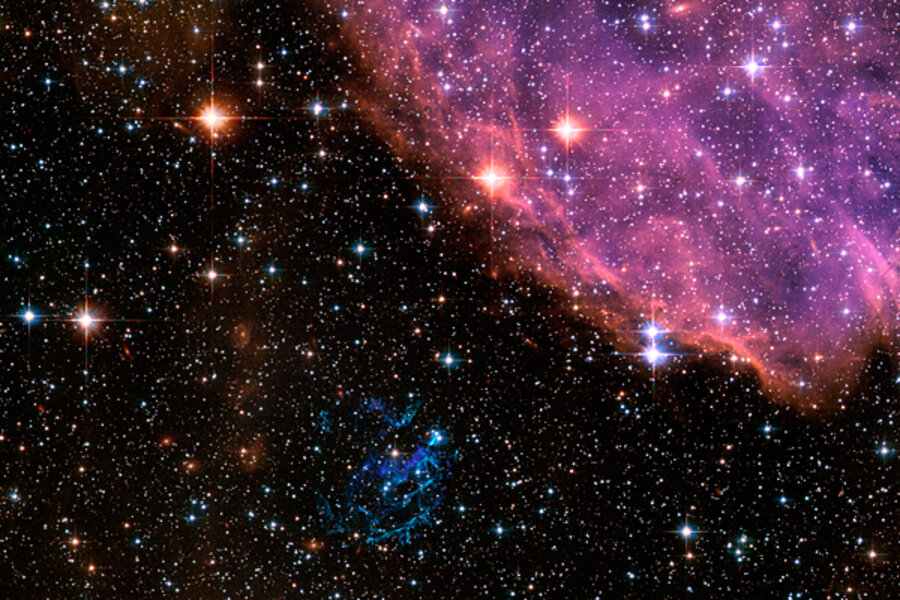Cosmic rays' mysterious origin? Supernovae to blame, study confirms.
Loading...
A century after an Austrian scientist discovered evidence for galactic cosmic rays, an international team of researchers has traced their source to exploded stars.
Such stars, known as supernovae, had previously emerged as prime suspects for generating cosmic rays – something of a misnomer, since galactic cosmic rays are protons that have been accelerated to nearly the speed of light.
But tracing these particles back to their sources is nearly impossible. Protons carry an electrical charge, so magnetic fields they encounter in their travels can deflect them. This can turn what might have been a straight-line path into a torturous one with lots of wide detours.
Using the Fermi Gamma-ray Space Telescope, researchers instead have detected gamma-ray emissions that are a byproduct of collisions between these turbocharged protons and their sluggish counterparts. The acceleration of these highly-energetic protons and the hapless subatomic crash dummies they hit appear inside the thin shell of material an exploding star casts into space.
Until now, the source of galactic cosmic rays has been one of the biggest unsolved puzzles in particle astrophysics, says Stefan Funk, at the Kavli Institute for Particle Astrophysics and Cosmology at the SLAC National Accelerator Laboratory in Menlo Park, Calif.
But data gathered from two supernova remnants over four years carry "a unique, smoking-gun signature that now, for the first time, provides incontrovertible evidence" that these expanding shells, known as supernova remnants, are accelerating protons, he says.
Dr. Funk notes that cosmic rays not only influence the evolution of galaxies, some biologists suspect they influenced the evolution of life on Earth by introducing mutations into the genes of simple forms of life early in Earth's history. Cosmic rays hitting the top of the atmosphere also trigger a shower of other particles that elevate radiation levels encountered by airliners. The rays also would represent a serious hazard to astronauts en route to Mars.
A formal report of the results will appear in Friday's issue of the journal Science. Funk and Pat Slane, an astrophysicist at the Harvard-Smithsonian Center for Astrophysics in Cambridge, Mass., reviewed the results in a briefing Thursday at the American Association for the Advancement of Science's 2013 annual meeting in Boston.
Cosmic rays were discovered by physicist Victor Hess in a series of balloon trips he conducted between 1911 and 1913. Filled with hydrogen, the balloons took him to altitudes as high as 17,400 feet.
Researchers had noted the presence of ionizing radiation at ground level, but thought it might have a terrestrial origin. Hess took sensitive detectors on his ascents and found that radiation levels increased with altitude, instead of decreased.
The discovery, confirmed 12 years later by US physicist Robert Millikan, earned Hess a Nobel prize in 1936. Thirteen years later, physicist Enrico Fermi would propose that cosmic rays were accelerated via collisions with moving magnetic fields in interstellar space.
Researchers since have refined the idea, with supernova remnants emerging as the most likely breeding ground.
In essence, the material a supernova sheds expands outward at speeds on the order of 22 million miles per hour, explains Dr. Slane, who was not a member of the team reporting the discovery. As this expanding shell plows through the dust and gas between stars, it sets up a shock wave along its outer edge that heats the gas and carries its own magnetic fields.
The magnetic fields can accelerate already existing cosmic-ray protons. And it can generate news ones by accelerating low-energy protons in the roiling hot soup of ionized gas in the shock wave.
The energy this process imparts to these protons is enormous – perhaps 10 million times higher than the energies achievable at the Large Hadron Collider in Europe, the most powerful Earth-bound particle accelerator.
Indeed, researchers have estimated that anywhere from 3 to 30 percent of the kinetic energy of the star's explosion gets transfered to the protons.
A tiny fraction of these protons escape to become cosmic rays. Others collide with other protons in the shock wave. When collisions occur, they create a short-lived particle known in physics-speak as neutral pions. Each pion immediately decays into two gamma-ray photons. The energy the gamma-ray photons carry represents the smoking gun, since that energy level is determined by the preceding chain of interactions. And, unlike protons, gamma-rays can travel in a straight line. This allowed researcher to pinpoint the sources.
In this case, the sources were the glowing remnant of a supernova about 5,000 light-years away dubbed the Jellyfish Nebula in the constellation Gemini. That star is thought to have exploded sometime between 3,000 and 30,000 years ago. The second source the team studied lies 10,000 light-years away in the constellation Aquila. Called W44, the supernova remnant is expanding within a larger, glowing cloud of dust and gas. The remnant is thought to be about 20,000 years old.
Protons from the aftermath of supernovae throughout the galaxy are though to comprise some 90 percent of the cosmic rays striking Earth's atmosphere. Collisions with the atmosphere generate a shower of other particles that represent the "rays" Hess picked up a century ago.
The Fermi Gamma-ray Space Telescope was launched from the US Air Force's launch complex at Cape Canaveral in Florida in June 2008. It's a cooperative mission spearheaded by NASA and the US Department of Energy, and includes partners in France, Germany, Italy, Japan, and Sweden.







